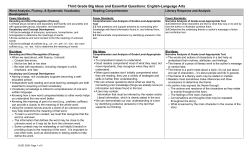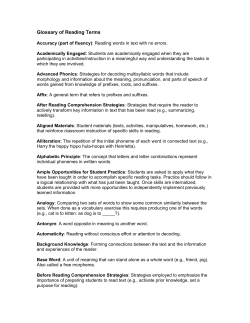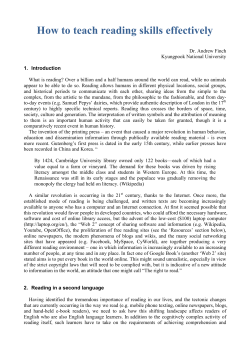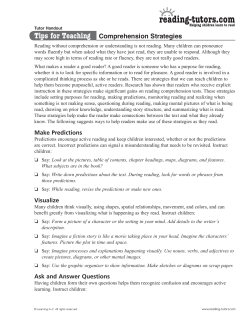
What Every Educator and Parent Should Know About Reading Instruction
What Every Educator and Parent Should Know About Reading Instruction By Joan Sedita, Ed.M. Published in “The Journal”, Nov 2001, Volume 11, No. 4, LDAM of Massachusetts. Updated in 2008. When I was at the Harvard Graduate School of Education in 1979, I was fortunate to have Dr. Jeanne Chall as my professor. Dr. Chall was a pioneer in research on reading. Beginning with her 1967 book “Learning to Read: The Great Debate”, Dr. Chall’s work until her death a few years ago set the standard for reading research. On the first day of class, she began with this quote, “As reading teachers, 60% of the children you teach to read will learn DESPITE the method you use.” Her message was that some children can readily become readers simply by being exposed to reading and some basic instruction, regardless of the method. However, I believe Dr. Chall wanted her graduate students to focus on those students who are at risk for learning to read, because they would be our challenge as reading teachers. She also impressed upon us that we would find the solutions to teaching poor readers through sound research rather than reading theory. Scientifically-Based Reading Research The “Great Debate” that Dr. Chall wrote about has continued for more than 30 years. The battle between “whole language” and “phonics” proponents that was so prevalent in the late 1990’s has somewhat subsided. Most reasonable educators now agree that no single method for teaching reading could ever be appropriate for all children, and that finding a balance between direct instruction in decoding and fluency skills and exposure to rich text to build vocabulary and comprehension is essential. However, there are still far too many educators who are not familiar with the research on effective reading instruction that is essential to guide decisions about how to teach reading and the appropriate materials to use. Thirty years ago the research on reading was limited, and educators had little to go on beyond reading theory. That has changed significantly; there is now a vast body of solid reading research that today’s educators can use teach reading. In the late 1990’s, the National Institutes of Health (through the National Institute of Child Health and Human Development), began reporting on a systematic review of critical advances in scientific research, and what that research could tell us about how good learners read, and the needs of at-risk readers (Lyon and Chhabra, 1996; Torgeson, et al, 1997; Foorman, et al, 1997). In 1997, Congress charged the NIH and the Secretary of Education to convene a national panel to assess the status of research-based knowledge, including the effectiveness of various approaches to teaching children to read. In April, 2000, the resulting National Reading Panel released its report “Teaching Children to Read: An EvidenceBased Assessment of the Scientific Research Literature on Reading and Its Implications for Reading Instruction”. The report highlighted and recommended a number of reading instruction strategies that were proven to be successful in teaching children to read, particularly for those children who are at risk for learning to read. The results are summarized later in this article. Since the report of the National Reading Panel was published, additional research findings have become available, including specific meta-analyses in the areas of comprehension and writing (RAND, 2002; Graham & Perrin, 2007). Also, a number of state and federal literacy initiatives, including the Reading First program of the No Child Left Behind legislation, were begun that are yielding additional information about how to deliver good reading instruction to all children to prevent children from becoming poor readers, and interventions to those students who do have reading disabilities. Reading research not only tells us what good readers need to learn to read; it also tells us what at-risk readers need to learn to read. Every educator and parent should have an understanding of the basic findings of research-based reading instruction. Administrators need this information so they can make informed decisions about reading programs, assessment, and training that they will use in their schools. Teachers need this information so they can provide quality reading instruction so every child can read. Parents need this information so they can monitor their child’s reading needs and progress, and be a knowledgeable participant when intervention plans are considered for children with reading difficulties. What the Research Tells Us There are five areas of reading instruction that must be addressed to successfully teach children to read: phonemic awareness, phonics, fluency, vocabulary, and text comprehension. The information below is summarized from “Put Reading First: The Research Building Blocks for Teaching Children to Read” (2001, published by the Partnership for Reading, National Institute for Literacy and the U.S. Department of Education). See references for information on how to obtain a copy of this publication. PHONEMIC AWARENESS INSTRUCTION Phonemic awareness is the ability to notice, think about, and work with the individual sounds in spoken words. Before children learn to read print, they need to become aware of how the sounds in words work. Phonemes are the smallest parts of sound in a spoken word. Children can show us that they have phonemic awareness in several ways, including: • Recognizing which words in a set of words begin with the same sound • Isolating and saying the first or last sound in a word • Combining or blending the separate sounds in a word to say the word • Breaking, or segmenting a word into its separate sounds Children who have phonemic awareness skills are likely to have an easier time learning to read and spell than children who have few or none of these skills. Phonemic awareness is NOT phonics. Phonemic awareness is the understanding that the sounds of spoken language work together to make words. Phonics is the understanding that there is a predictable relationship between sounds and the letters that represent those sounds in written language. If children are to benefit from phonics instruction, they need phonemic awareness. Direct phonemic awareness instruction should begin in kindergarten and continue through first and second grades. Some children with reading difficulty may need additional phonemic instruction beyond second grade. Phonemic awareness instruction teaches children to notice, think about, and work with sounds in spoken language. Typical activities to build phonemic awareness include: • identifying the individual sounds in a word • recognizing the same sounds in different words • listening to a sequence of separately spoken sounds and then combining them to form a word • breaking a word into its separate sounds saying each sound as they tap out or count it • recognizing the word that remains when a sound is removed • making a new word by adding a sound to an existing word • substituting one sound for another to make a new word • recognizing the word in a set of words that has the “odd” sound Phonemic awareness instruction improves children’s ability to read words. It also improves their reading comprehension because rapid and accurate reading of words enables students to focus on understanding. It also improves spelling because it helps children understand that sounds and letters are related in a predictable way. Phonemic awareness instruction is most effective when children are taught to manipulate sounds by using the letters of the alphabet; children should therefore be taught letter names and shapes along with phonemic awareness. PHONICS INSTRUCTION Phonics instruction teaches children the relationship between the letters of written language and the individual sounds of spoken language. It teaches children to use these relationships to read and write words. The goal of phonics instruction is to help children learn and use the alphabetic principle – the understanding that there are systematic and predictable relationships between written letters and spoken sounds. Knowing these relationships will help children recognize familiar words accurately and automatically, and “decode” new words. Phonics instruction teaches children a system for remembering how to read words, whether they contain predictable word patterns or if they are irregularly spelled. Phonics can be taught effectively to the whole class, to small groups, or to individual students, depending on the needs of each student. Approximately two years of phonics instruction is sufficient for most students, and should begin in kindergarten or first grade. A key finding from the scientific research on reading is that systematic and explicit phonics instruction is more effective than non-systematic or no phonics instruction. The difference between systematic and non-systematic phonics programs is that systematic phonics teaches a set of letter-sound relationships (both consonants and vowels) in a clearly defined sequence. A systematic phonics program also provides materials that give children substantial practice in applying knowledge of these relationships as they read and write. These materials include books or stories that contain a large number of words that children can decode by using the letter-sound relationships they have learned (controlled text). Phonics programs that are not systematic do not teach consonant and vowel letter-sound relationships in a prescribed sequence. Rather, they encourage informal phonics instruction based on the teacher’s perceptions of what students need to learn and when they need to learn it. Key findings from the research on systematic, explicit phonics instruction include: • It improves kindergarten and first-grade children’s word recognition and spelling for children from various social and economic levels • It significantly improves reading comprehension • It is particularly beneficial for children who are having difficulty learning to read and who are at risk for developing future reading problems • It is most effective when introduced as early as kindergarten and first grade • It is not an entire reading program for beginning readers; they must also be listening and reading stories and informational texts FLUENCY INSTRUCTION Fluency is the ability to read a text accurately and quickly. When fluent readers read silently, they recognize words automatically. They group words quickly to help them gain meaning from what they read. Fluent readers read aloud effortlessly and with expression. Readers who have not yet developed fluency read slowly, word by word. Their reading is choppy and plodding. Fluency is essential for reading comprehension. Because fluent readers do not have o concentrate on decoding the words, they can focus their attention on the meaning of the text. Less fluent readers must focus their attention on figuring out the words, leaving them little attention for understanding the text. Fluency develops gradually over considerable time and through substantial practice. Fluency can change, depending on what readers are reading, their familiarity with the words, and the amount of their practice with the reading text. Even very skilled readers may read in a slow, labored manner when reading texts with many unfamiliar words or topics. It is important to note that although some readers may recognize words automatically in isolation or on a list, they may not read the same words fluently when the words appear in text. These students are not able to transfer their decoding ability with speed and accuracy when they are reading. Research on effective fluency instruction has found that repeated and monitored oral reading improves fluency and overall reading achievement. Students who read and reread passages orally as they receive guidance and/or feedback become better readers. Repeated oral reading substantially improves word recognition, speed and accuracy, as well as fluency. On the other hand, no research evidence is available to confirm that instructional time spent on silent, independent reading with minimal guidance and feedback improves reading fluency or overall reading achievement. Class work that has students reading on their own (for example, Silent Sustained Reading) has not proven to be helpful for students who have fluency difficulties. The research suggests that there are more beneficial ways to spend reading instructional time than to have students read independently. Students can become more fluent readers when teachers provide them with models of fluent reading, and by having them repeatedly read passages as they offer guidance. Teachers should read aloud daily to their students to model how a fluent reader sounds during reading. They should develop reading fluency by providing students with many opportunities to read the same passage orally several times. The passages should be at the student’s “independent reading level”. That means the text should contain mostly words they know or can decode. The passage should also be relatively short, between 50 to 200 words. A variety of reading materials (stories, nonfiction, poetry) should be used. There are several ways students can practice orally rereading text, including: • Student-adult reading: the student reads one-on-one with an adult. The adult reads the text first, then the student reads the text with the adult providing assistance and encouragement. • Tape-assisted reading: students read along in their books as they hear a fluent reader read the book on an audiotape. For the first reading, the student should follow along, pointing to each word. Next the student should try to read aloud along with the tape. This should continue until the student is able to read without the support of the tape. • Partner reading: paired students take turns reading aloud to each other. More fluent readers can be paired with less fluent readers. The stronger reader reads aloud first, then the less fluent reader reads the same text aloud. The stronger student gives help with word recognition and provides feedback and encouragement to the less fluent partner. VOCABULARY INSTRUCTION Vocabulary plays an important role in learning to read, and it is very important to reading comprehension. Readers cannot understand what they are reading without knowing what most of the words mean. As students learn to read more advanced texts, they must learn the meaning of new words that are not part of their every-day vocabulary. The research on vocabulary instruction tells us that (1) children learn the meanings of most words indirectly, through everyday experiences, and (2) some vocabulary must be taught directly. Indirect vocabulary learning happens when students hear and see words used in different contexts. This can happen through conversations, especially with adults; from listening to adults read aloud, especially when unfamiliar words are defined and discussed; and when students read extensively on their own – the more they read, the more words they encounter, and the more word meanings they learn. Direct vocabulary learning happens when students are explicitly taught both individual words and word-learning strategies. Specific word instruction includes reviewing new vocabulary words before reading and by providing time when students can work actively with new words. The more they use new words, the more likely they are to learn them. Students also need to be taught strategies for determining a new word independently. This includes learning how to use dictionaries and other reference aids; how to use information about word parts to figure out the meanings of new words (i.e., roots, suffixes and prefixes); and how to use context clues to determine word meanings. TEXT COMPREHENSION INSTRUCTION Comprehension is the ability to determine meaning from text. It is a complicated, interactive process, where readers construct meaning based on the information they get from the text combined with their own knowledge. Good readers are both purposeful and active. The research on comprehension instruction indicates that comprehension can be improved by instruction that teaches students to use specific comprehension strategies. There are six strategies that appear to have the most scientific basis for improving text comprehension: 1. Monitoring comprehension: students monitor their comprehension and know when they do or do not understand what they are reading. Students are taught strategies for recognizing and “fixing up” problems in their understanding as they arise. 2. Using graphic and semantic organizers: graphic organizers (e.g., maps, webs, charts, graphs) help readers focus on the main concepts and how they are related to other concepts. They are especially helpful for text in the context areas, such as science or social studies. Graphic organizers help students focus on text structure as they read, provide tools to visually represent the ideas they are learning, and help students write summaries of the text. 3. Answering questions: teacher questioning supports comprehension because it gives students a purpose for reading, focuses their attention on what they are to learn, helps them think actively as they read, encourages them to monitor their comprehension, and helps them relate what they already know to the content. 4. Generating questions: teaching students to ask their own questions improves their active processing of the text. By generating questions, students become aware of whether they can answer the questions and if they understand what they are reading. 5. Recognizing story structure: story structure refers to the way the content and events of a story are organized into a plot. Students learn categories of content such as setting, initiating events, attempts, outcomes, etc. and how this content is organized into a plot. Story maps are useful for illustrating story structure. 6. Summarizing: a summary is a synthesis of the important ideas in the text. When students summarize, they determine what is important, they condense this information, and they put it into their own words. Teaching summarizing helps students identify main ideas, connect ideas, eliminate irrelevant information, and remember what they read. Research also shows that comprehension strategies can and should be taught explicitly and directly to students. This means explaining why and when strategies should be used, and how to apply them. Explicit instruction includes direct explanation, modeling, guided practice, and application of a strategy. Putting It All Together In today’s schools, too many children struggle with learning to read. While there are no easy answers or quick solutions for optimizing reading achievement, there now exists extensive research about the kind of instruction that needs to be given to children so they can learn to read well. All educators and parents must understand how instruction in phonemic awareness, phonics, fluency, vocabulary and text comprehension can help meet the goal of having every child be a reader by the end of third grade. For our communities, we must become well-versed in science-based reading instruction in order to affect school-wide policy. For our own children, we must do this to be sure they are receiving the best possible instruction in reading. REFERENCES Foorman, Barbara; Francis, David; Fletcher, Jack. (1997). NICHD Early Interventions Project. Perspectives, Fall, 1997. Graham, S., & Perrin, D. (2007). Writing next: Effective strategies to improve writing of adolescents in middle and high schools – A report to Carnegie Corporation of New York. Washington, DC: Alliance for Excellent Education. Lyon, G.Reid; Alexander, Duane. (1997). Their World, 1996-1997. National Reading Panel. (2000). Teaching Children to Read: An Evidence-Based Assessment of the Scientific Research Literature on Reading and Its Implications for Reading Instruction. Publication of the National Institutes of Health. No Child Left Behind press release. (2002) Reading First in Massachusetts. www.NoChildLeftBehind.gov The Partnership for Reading. (2001). Put Reading First: The Research Building Blocks for Teaching Children to Read. Publication of the Nationa Institute for Literacy, U.S. Department of Education. Free copies of this publication can be ordered by contacting: ED Pubs, P.O.Box 1398, Jessup MD, 20794. Phone: 1-800-228-8813. The publication can also be downloaded from the National Institute for Literacy website www.nifl.gov RAND (2002). Reading for understanding: Toward a R&D program in reading comprehension. Santa Monica, CA: RAND Education Torgeson, Joseph; Wagner, Richard; Rashotte, Carol; Alexander, Ann; Conway, Tim. (1997). Preventive and Remedial Interventions for Children with Severe Reading Disabilities. LearningDisabilities, Vol. 8, No. 1, 51-61. About the author: Joan Sedita is the founding partner of Keys to Literacy, a consulting and teacher training service in Rowley, MA. She has worked for over 30 years in the education field, and has presented training to thousands of teachers, parents, and related professionals at schools, colleges, clinics, and professional organizations throughout the country. She specializes in consultation and training in K-12 reading instruction. Joan worked at the Landmark School in Massachusetts for 23 years as a teacher, supervisor, and high school principal. She was also the founder and director of the Landmark College Preparation Program, and director of the Landmark Outreach Teacher Training Program. Joan was one of three Lead Trainers in Massachusetts for the NCLB Reading First Initiative. She was also a National LETRS Trainer, an adjunct instructor at Fitchburg State College, and a member of the Praxis National Reading Advisory Board. She received her Masters in Reading Education from Harvard University in 1980, and her B.A. from Boston College in 1975. Joan has authored the following books: “The Key Three Routine: Comprehension Strategies”; “The Key Comprehension Routine”; “The Key Vocabulary Routine”; “The ANSWER Key to Open Response”; LETRS Module 11 “Writing: A Road to Reading Comprehension” (co-author with Louisa Moats); “Active Learning and Study Strategies Using Kurzweil 3000”; “The Landmark Study Skills Guide”. Additional information about publications, training, and resources can be found by visiting www.keystoliteracy.net
© Copyright 2025





















